How to grow purple roses and which varieties to choose
A purple rose is a symbol of love at first sight. The way of expressing feelings with the help of flowers dates back to the Victorian era, where roses were the best means of expressing emotions and intentions. Royals preferred the color purple. Roses in lilac, lilac, violet, and lavender shades appeared thanks to the efforts of flower growers. Compositions of flowers of a similar shade look elegant and rich.
Features of purple roses
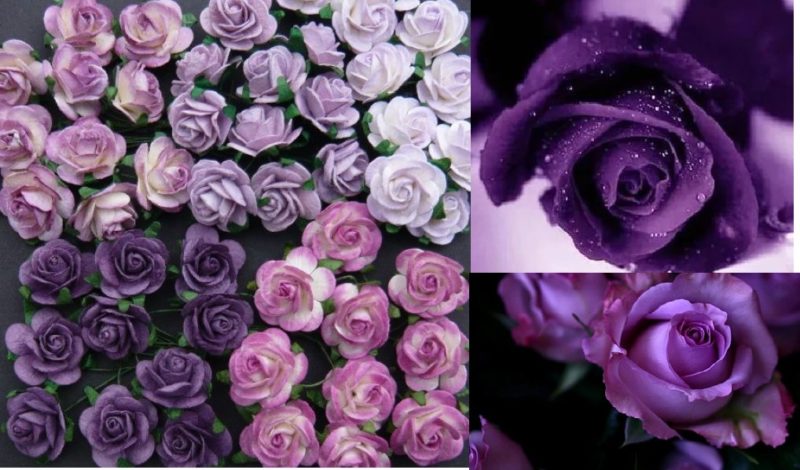
Purple roses are the conventional name of a flower group with buds in blue, lilac, lilac, and lavender shades. This color does not occur in nature; it is the result of painstaking selection work.
The pansy gene is responsible for the unusual purple hue. Breeders have not yet been able to achieve a pure color without impurities. Existing varieties are distinguished by a special lilac hue and tend to change it depending on the intensity of light and the stage of flowering.
Interesting! In ancient Rome, different varieties of roses were grown, which were used to decorate gardens and religious festivals. In his writings, Herodotus mentions black, green, combined, and purple colors of roses.
A turning point in the history of purple rose breeding came in 1867, when A. Guyot created a new variety called La France. On its basis, a hybrid tea group subsequently developed.The American Rose Society developed a modern classification in 1976, which was approved by the World Federation of Rose Societies (WFRS). Roses began to be divided into groups and classes taking into account garden, rather than species, characteristics, as was previously the case.
Breeders all over the world are working to create new varieties, using greenhouse complexes equipped with modern climate control technologies, automatic watering and fertilizing systems.
Popular varieties of purple roses
Despite the fact that developing new varieties of roses takes a lot of time, their diversity is amazing.
Blue for You
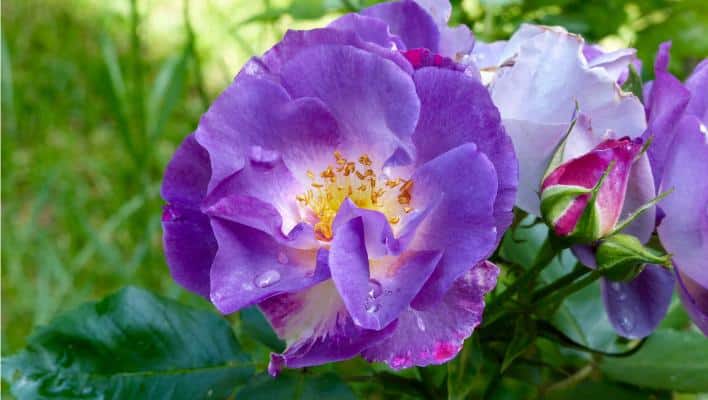
A dense, low-growing bush no higher than 1 m. The shoots are straight, the leaves are dark green. 4 buds are formed on one branch.
The flowers are medium or small in size, but abundant flowering visually makes the bush lush. Petals are semi-double, large, light lilac in color. The aroma is strong. Resistance to cold and disease is average.
Cardinal de Richelieu
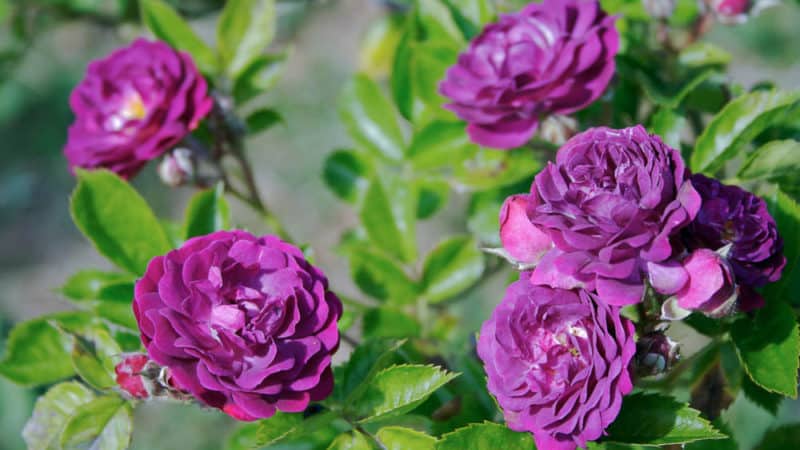
Tall bush - about 2 m, erect. The flowers are double, large, voluminous. The petals are dark purple with a white center.
Single buds and inflorescences of 3 flowers are formed on the shoots. It blooms once a season, but long and abundantly. The aroma is sharp, very specific. Resistance to cold and disease is high.
Rhapsody in Blue
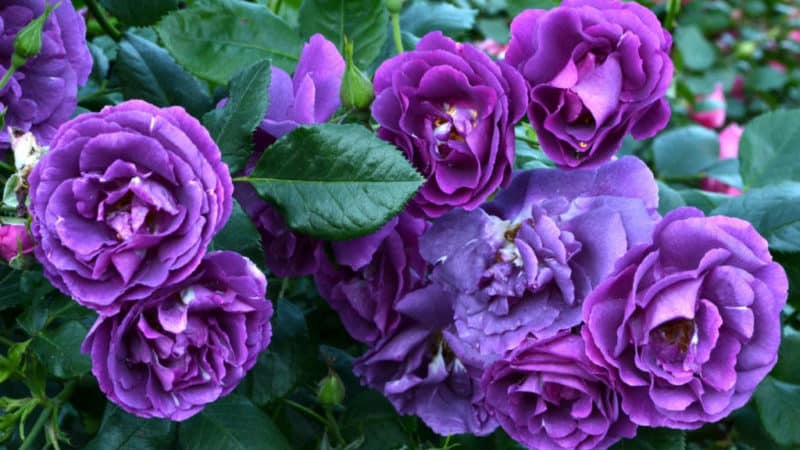
The Blue Rhapsody variety was named for its blue color. At the stage of bud formation, the petals are colored dark blue; as they open, they lighten in the sun. Core with yellow stamens.
Flowers are medium sized, semi-double. Lush inflorescences form on the shoots. The aroma is delicate. The bush is straight, no higher than 1.5 m. Resistance to cold, high humidity and diseases is high.
Moje Hammarberg
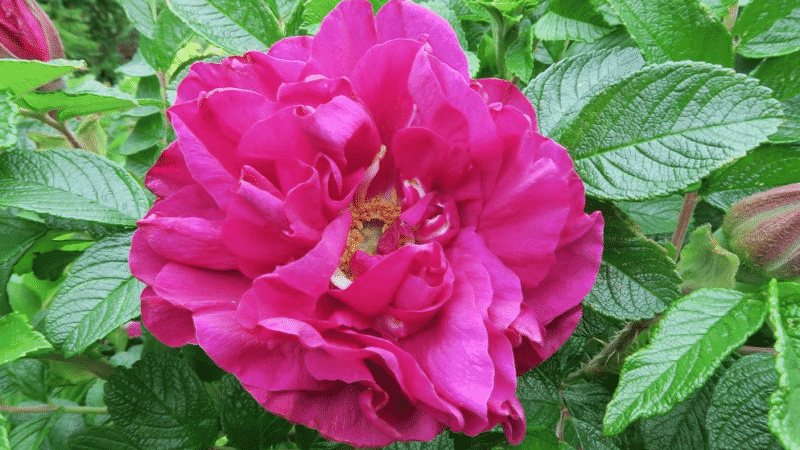
The bush is strong, branched, 80-120 cm high. The leaves are long and light. The shoots are thick and prickly. Double flowers, medium size. The petals are red-violet, the core has yellow stamens. The aroma is strong. One bud or inflorescences of 3-5 are formed on the shoots. Resistance to cold and disease is average.
The rose blooms 2-3 times a season, profusely the first time, then moderately. Before the onset of cold weather, a large number of flowers appear on the bushes. Resistance to cold, moisture deficiency and disease is high.
Florence Delattre
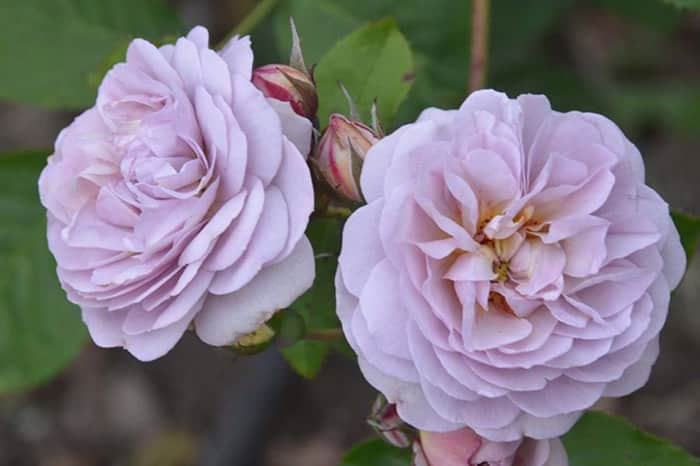
One and a half meter spreading bush with straight shoots. The leaves are large, dark green. It blooms in large inflorescences, the flowers are rounded up to 10 cm in diameter, densely double. The petals are light lilac with a yellowish core.
The variety is distinguished by color variations - on one bush there are flowers of different shades depending on humidity, lighting, and air temperature. The rose blooms in waves, 2-3 times a season. The aroma is pleasant, medium intensity. Resistance to diseases is high, resistance to cold and heavy rainfall is low.
Perennial Blue
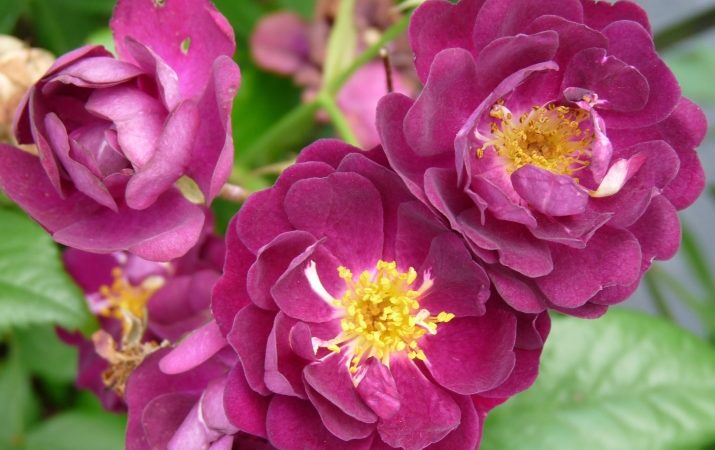
Climbing bushes are used to decorate garden fences and gazebos. The plant reaches 3 m in height and needs support. There are almost no thorns on the shoots. The buds are small, up to 3 cm in diameter, semi-double. The petals are light purple in color with a white center.
A large number of inflorescences are formed on the shoots. Flowering is abundant and long lasting. The aroma is bright, sweet, pronounced. Resistance to cold and disease is high.
Blue River
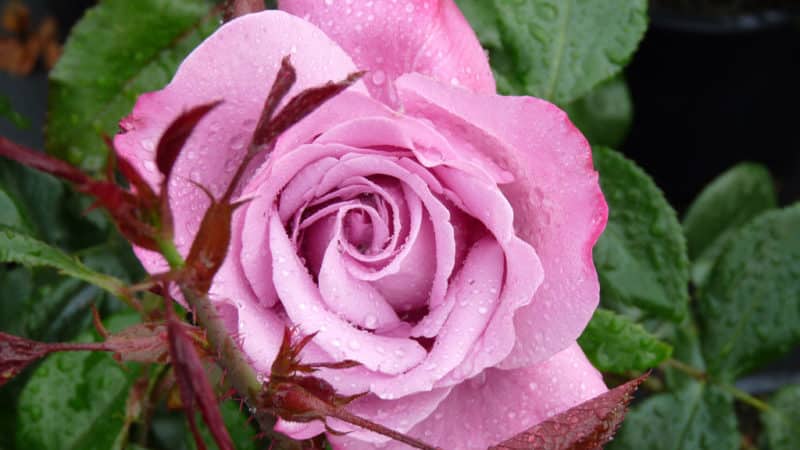
The bushes are meter tall, branched. On strong shoots, single flowers with a diameter of 10-11 cm are formed. The buds are round, full, double.A characteristic feature is a light lavender-lilac color in the middle, flowing into a dark crimson-lilac at the edges.
The color changes as it opens. The aroma is bright and pleasant. Flowering lasts until the end of the season. The plant loves the sun, is characterized by resistance to heat and moisture deficiency, and to a lesser extent to diseases and excessive watering.
Types of purple roses
In nature, there are many types of purple roses: peony, bush, climbing, hybrid tea, park, standard, Dutch, English, bush, large and miniature.
Peony-shaped

Peony roses are the result of crossing old English and tea roses. The authorship belongs to farmer David Austin.
The species is divided into 2 groups: roses for garden and commercial cultivation. The first group is valued for its immunity to disease and lush flowering, the second for its aesthetics and resistance to cold.
The most popular variety of peony roses is Darcey Bussell. This is a compact plant, adapted for growing indoors and in open ground.
At the beginning of flowering, the petals are painted crimson, towards the end they acquire a purple tint, so the bushes appear dark burgundy.
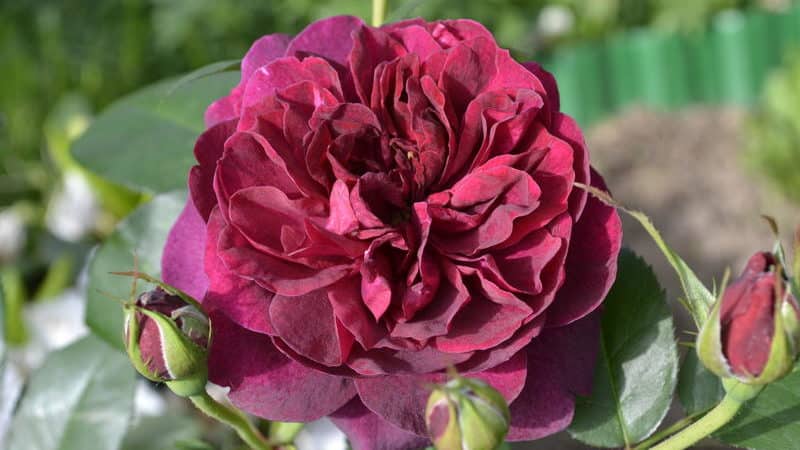
Climbing
Climbing roses are distinguished by very tall inflorescences. The length of the stem reaches 5 m. The plant is often used to decorate fences or gazebos. Climbing purple roses are the result of crossing Japanese, wild and hybrid tea roses.
These varieties reach 15 m in height. The buds themselves are soft and small. The plant remains green until the onset of cold weather and prefers clay soil. Perennial Blue, the most popular variety with double flowers, has a crimson-violet color.
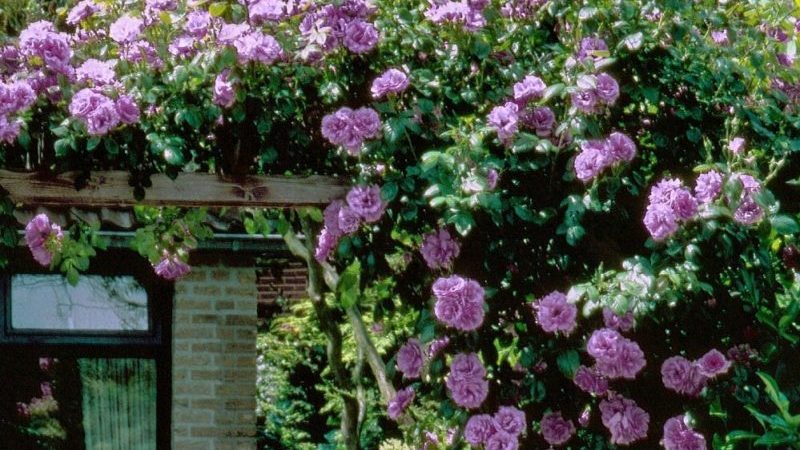
Hybrid tea
Rose growers obtained this variety as a result of crossing remontant and tea varieties. The flowers turned out large, with a charming aroma. The height of the bush is 80-120 cm.
The varieties tolerate winter well and are characterized by amazing vitality.
Popular varieties:
- Paradise grown in the garden and at home. The bush reaches 1 m in height, the diameter of the bud is 6 cm. The flowering period is early spring - late autumn. The shoots are covered with many prickly thorns.
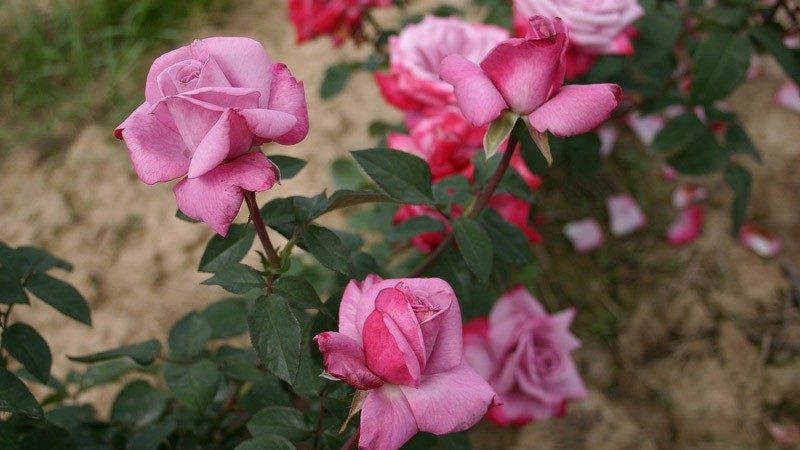 Paradise
Paradise - Big Purple - terry-velvety cup-shaped buds, 13 cm in diameter. Bush height - 1-1.2 m. Roses bloom twice a season.
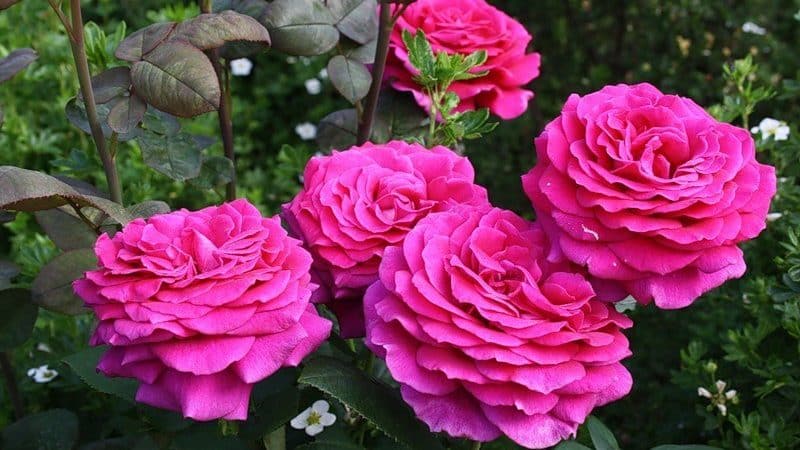 Big Purple
Big Purple - Blue Nile - double buds of a soft purple color, 12 cm in diameter. The height of the bush is 1.5 m. The shoots are covered with many thorns. The plant is resistant to diseases and heavy rains.
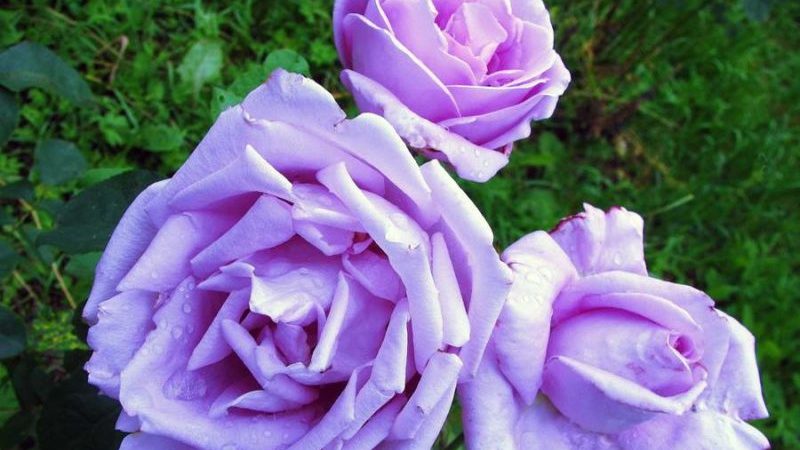 Blue Nile
Blue Nile
Park
Park roses are a cultivated variety of rose hips. The plant is characterized by rapid growth, voluminous bushes and dense buds. Flowering period - late spring - mid-autumn. The petals are painted in a rich purple color. The leaves are brightly colored. Each bud has at least 150 petals. The variety is suitable exclusively for garden cultivation.
The most famous representative of the species is Cardinal Richelieu.
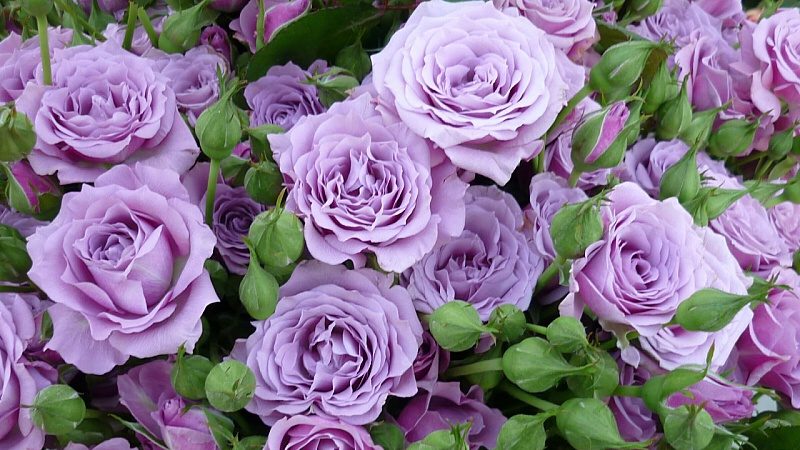
Standard
Standard roses come in short and tall varieties. The bush is created from any varieties by grafting to rose hips. Life expectancy is 4 years.
The main advantage of the variety is its long and lush flowering.
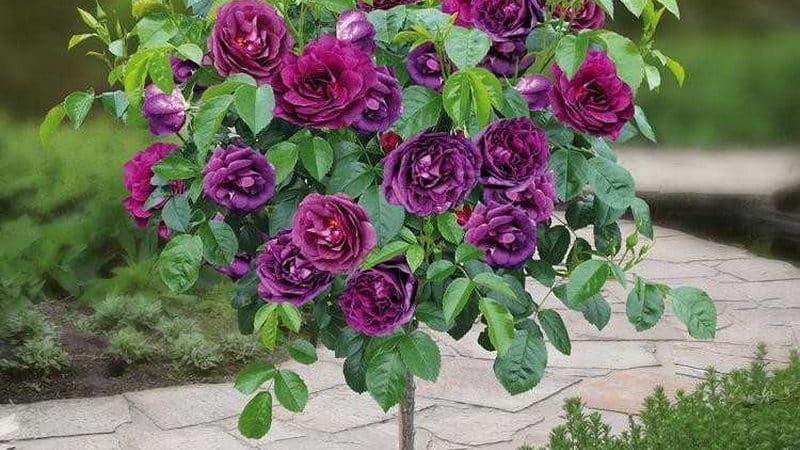
Ground cover
Ground cover roses are used to decorate the landscape. The main feature of the species is its creeping form. The shrub grows up to 70 cm in width and has long and lush flowering.
Variety Rosa Veg der Zinne resistant to various diseases. The diameter of the bush reaches 50 cm, the height does not exceed 70 cm. The buds consist of 7-8 petals of violet-purple color with a rich yellow center. The diameter of the flower is 8 cm. The variety is grown in the garden, at home in a large pot, or in a flower garden.
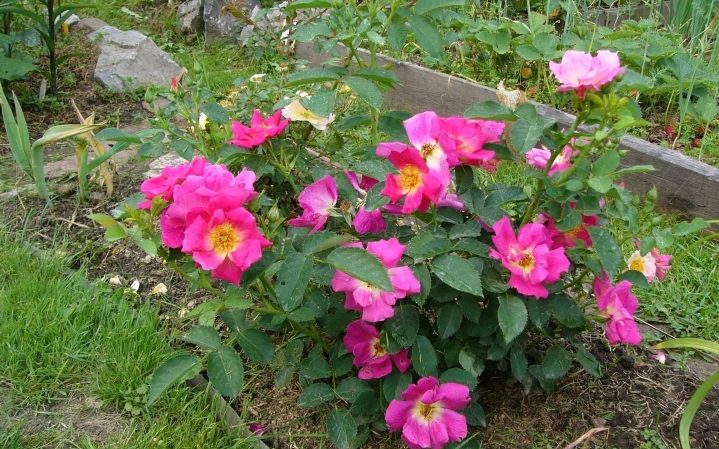
Dutch
Dutch roses are a kind of sign of quality. Medium-sized buds attract attention with bright, rich colors. Florists collect beautiful bouquets from Dutch varieties of roses. Cut flowers can stand in water for up to 2 weeks.
Variety Charles de Gaulle is especially popular due to its pale purple color and dense bud structure. The diameter of the flower is 10 cm, the diameter of the bush is 1 m.
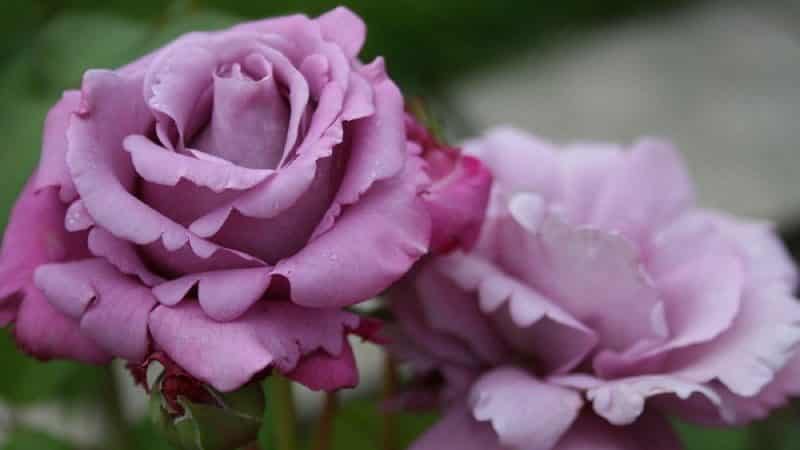
Bush
Shrub roses bloom long and abundantly with single flowers or group inflorescences of 150-200 pieces. The buds are large or small, of various shapes. Shrub roses withstand cold and hardly get sick.
Variety Blue Moon It is distinguished by large flowers of a regular cup shape, with a diameter of 12-13 cm. No more than 3 shoots are formed on the stem. Neat bushes reach 1.2 m in height.
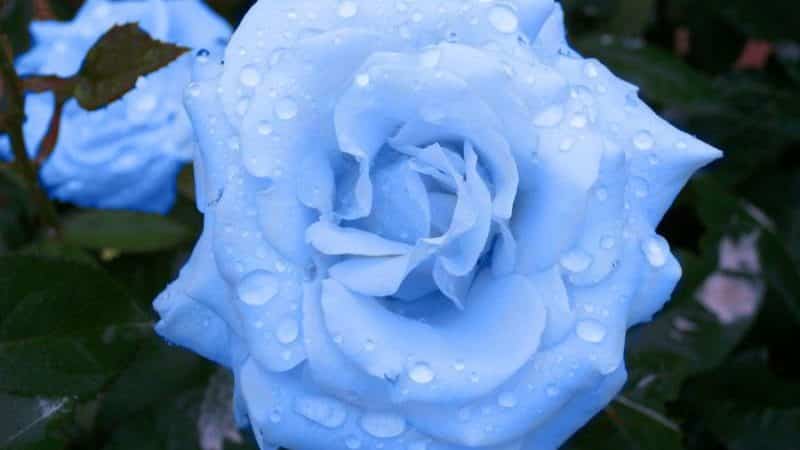
Variety Lavender Dream It is distinguished by unusual flat flowers. The low bush blooms long and profusely. The diameter of the bush does not exceed 65 cm. The color of the petals is delicate lavender.
English
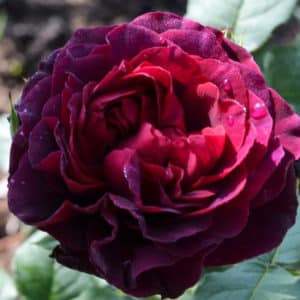
English roses are distinguished by their amazing aroma, perfect cup-shaped or rosette-shaped shoots, even color of buds without any inclusions of other flowers.
Variety Prince It is unique in its rosette-shaped buds and, when blooming, acquires a thick red color, which changes to purple-violet. The diameter of the flower reaches 5 cm.
Large
The species combines varieties with large buds with a diameter of 12-18 cm. The height of the bushes is up to 2 m. Single flowers or numerous inflorescences are formed on the shoots. The varieties are resistant to disease and frost.
Paul Neuron - a giant among roses. The bud size reaches 18 cm. 1-3 shoots are formed on each stem. The petals have wavy edges and are colored deep pink with a purple tint.
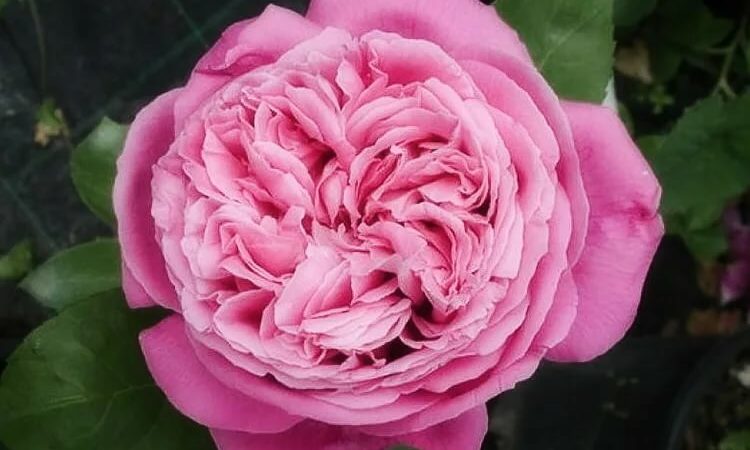
Miniature
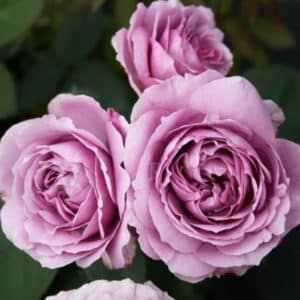
Dwarf, or border, roses are low-growing plants that rarely exceed 20 cm in height.
Some varieties reach a maximum of 50 cm. This is a lush variety with many small buds. The shape and color of the flowers depend on the variety. Flowering period: spring, summer, autumn. With reliable shelter, the plant can easily withstand harsh winters. Dwarf roses are successfully grown at home.
Variety Lavender grows up to 40 cm, bud diameter up to 4 cm. After opening, the flower becomes soft purple with a lavender tint.
Variety Amulet - the largest among dwarf species. The height of the bush is 50 cm. Terry petals of bright pink-violet color form flowers with a diameter of 5-7 cm.
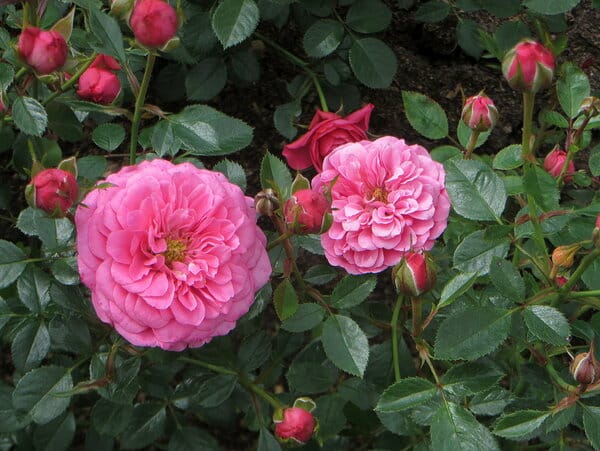
Using purple roses in landscape design
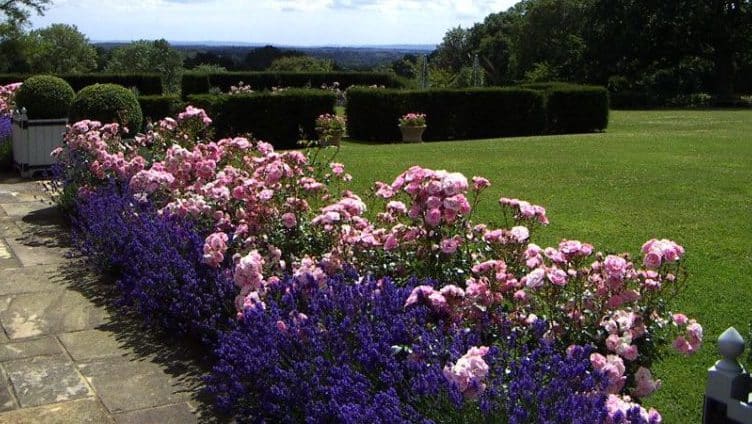
Garden roses are ideal plants for decorating flower beds in the country, near a private house, gazebos and verandas. Purple roses go well with lilac, pink, white, and yellow shades.
When planting, taller bushes are placed in the center or in the background. Spreading plants are planted singly, and straight ones are framed with low-growing bushes or creeping conifers. A backing made of herbaceous plants is a good solution, creating the effect of a green carpet.Tall trees (arborvitae, cypresses) or standard varieties look great in the background.
How to Grow Purple Roses
Rose is a capricious and finicky culture; in an unsuitable environment it stops blooming or dies altogether. To ensure that the plant enjoys abundant and long-lasting flowering, gardeners recommend following the rules of planting and growing.
The necessary conditions
The most suitable type of soil is loose, fertile loam with medium acidity. If the land on the site does not meet the requirements, it is recommended to improve the indicators depending on its type:
- heavy soil is loosened using river sand, humus, and peat;
- chalk or slaked lime is added to acidic soil to equalize the pH;
- Clay is added to too loose sandy soil.
Roses do best in well-lit areas, but without direct sunlight, which causes dull color. The best option is to plant in an area where there is more light in the first half of the day than in the second. In the afternoon, roses like to rest in partial shade.
Reference. Roses do not grow well in the shade and hardly bloom in conditions of limited sunlight.
The queen of the garden is very capricious and does not tolerate drafts, so the bushes are planted along walls or fences, protecting them from gusty winds.
Roses love water, but do not respond well to overflow. Stagnant moisture in the root area leads to rot and death of the entire bush.
The rose requires regular watering, but does not tolerate stagnation of moisture at the roots. It is recommended to plant plants on hilly areas, which allow excess water to flow down freely.
Landing
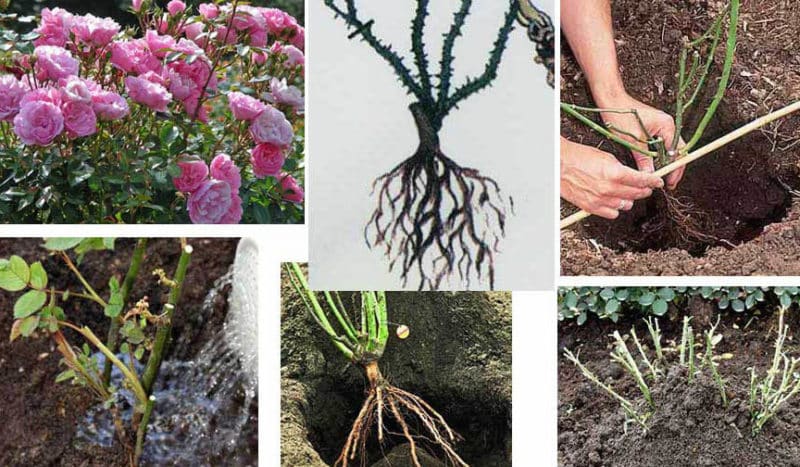
Roses are planted in autumn, October is best.. The exception is seedlings obtained by the method cuttings, they are planted in the spring.
In the prepared area, dig a hole free enough to accommodate the root system of the seedling. The bottom is loosened, the plant is placed, the roots are straightened, sprinkled with earth, making sure that the pinched area is under a 10 cm layer of soil. Then the soil is compacted and mulched with compost.
When planting in spring, compost is placed at the bottom and clean soil is poured on top. The tree trunk circle is slightly loosened and covered with a layer of peat, compost or straw.
Care
In the first year after planting, special attention is paid to watering. During the dry period, the rose garden is moistened 2 times a day. For irrigation, use warm, settled water, which is poured under the root, without getting on the leaves and buds.
In the spring they perform sanitary pruning - remove dry, dead shoots. To give the bush a neat shape, trim the branches growing inward. In summer, faded buds, too long shoots, and limp leaves are cut off.
Feeding contribute throughout the season. To do this, use organic matter (humus, manure, wood ash) and ready-made liquid fertilizers with minerals. To stimulate the appearance of buds, the drugs “Epin”, “Zircon”, “Bud” are used.
An infusion of chicken manure (1:15) or mullein (1:10) is added when watering in the morning or evening.
Before the first buds appear, nitrogen and high-quality ready-made mixtures containing phosphorus and potassium are added to the soil.
After flowering, the flowers are fertilized with potassium and phosphorus (“Kemira universal”) and mullein infusion.
Mineral fertilizer "Gloria" contains magnesium, calcium and supports flowering. The fertilizer is evenly scattered under the bush and embedded in the soil.
Pest control (mites, larvae) and diseases (rust, gray mold, powdery mildew) are controlled with the help of fungicides and insecticides.
For prevention, plants are regularly inspected, old, limp, diseased leaves and flowers are removed. Diseased branches are cut off and burned away from the site. The bushes are treated with a 3% solution of Bordeaux mixture.
Advice from experienced flower growers
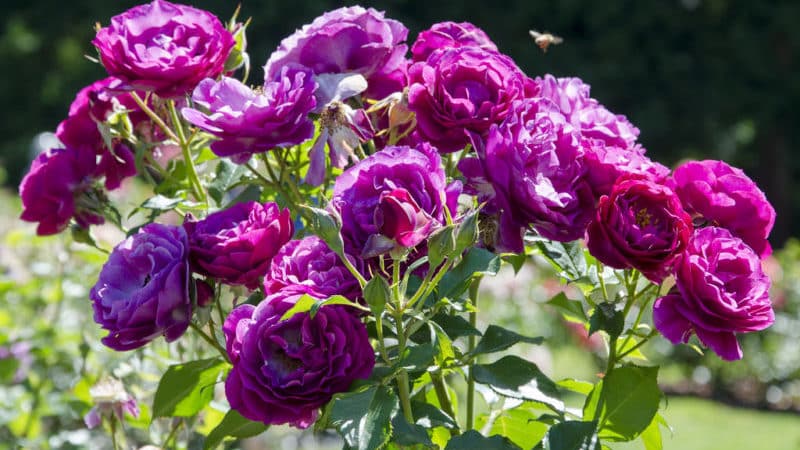
Care for purple roses is the same as for roses of other colors:
- During the period of budding and flowering, fertilizers are applied only at the stage of intensive bud formation. During flowering, feeding is stopped. Organic and mineral compounds are added after flowering.
- Roses love nitrogen fertilizers, but they should be applied in moderation and completely eliminated from mid-June.
- Pressed yeast is an excellent replacement for a store-bought solution with microelements. 1 kg of fresh yeast is dissolved in 10 liters of warm water, and before use it is diluted with water 1:10. Consumption for 1 bush - 1 liter.
- Rotted manure is applied in the fall, and in mid-summer an infusion of chicken manure is poured under each bush.
- Wood ash is used when growing flowers in acidic soils. The water suspension prolongs flowering and saturates the plant with additional microelements.
- Fading buds are cut off as soon as the petals begin to fade.
- When pruning flaccid buds, be careful not to pinch the peduncle, which threatens to weaken the shoots.
- After trimming, the cut areas are covered with PVA glue to prevent the development of fungal infections.
- To decorate slopes and slopes, ground cover rose species are used.
- The best sun to shade ratio is 70% and 30% respectively.
- It is advisable to lay the rosary in the direction of the south or southwest. This way the area is better illuminated and heated by the sun, and the risk of developing fungal diseases is reduced significantly.
Conclusion
Purple roses have many shades: lilac, lilac, plum, lavender. These flowers look amazing and attract attention. The pansy gene is responsible for the unusual purple hue.
In nature, there are peony, climbing, hybrid tea, park, standard, bush, and ground cover species. Buds can be large or miniature, bushes can be tall or low. Lilac roses fit perfectly into an ensemble of flowers, bushes and trees, so they are often used to decorate home areas.